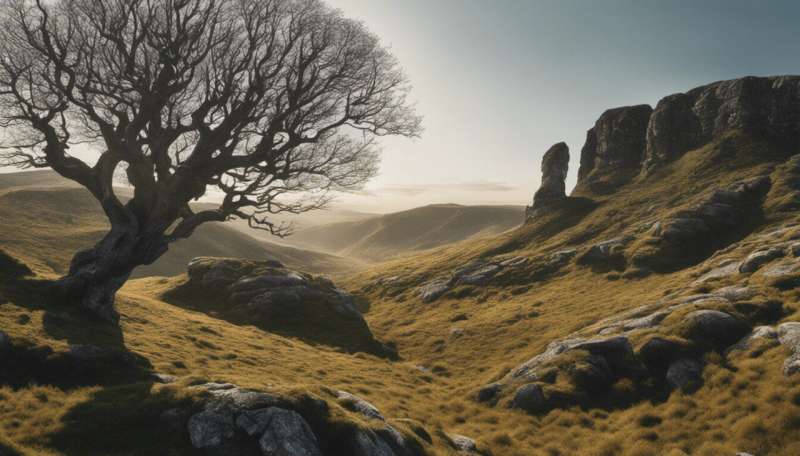This article has been reviewed according to Science X's editorial process and policies. Editors have highlighted the following attributes while ensuring the content's credibility:
fact-checked
trusted source
written by researcher(s)
proofread
Sycamore Gap: What the long life of a single tree can tell us about centuries of change

Only a few individual trees could be rightly labeled as world famous, but the tree at Sycamore Gap along Hadrian's Wall in northern England was one of them. No wonder its recent felling provoked public outcry and collective mourning.
The tree's dramatic and photogenic setting made it a culturally significant landmark, often used as a symbol of the surrounding Northumberland region. However, this single tree also symbolized our relationship with the landscape in this part of the world, both past and future.
Sycamores (Acer pseudoplanatus) are not a native species but were introduced to Britain around 500 years ago and properly established themselves over the past 200 years. As aggressive colonizers, for a long time sycamores were an enemy of both conservationists and foresters.
In 1662 the writer and gardener John Evelyn wanted them "banish'd from all curious gardens and avenues" for the mess they created from leaves often splattered with a sticky liquid secreted by small insects, known as honeydew.
It is in fact this honeydew and leaf fall that create some of the ecological value of sycamores, since the aphids that produce the honeydew are an invaluable source of food for predatory insects and birds. Sycamores are also often found in soil with lots of different fungal species, and they're an important habitat for lichens.
Sycamores are able to resist strong winds and cold and are also a likely replacement for those ash trees which are being attacked by a fungal pathogen known as ash dieback. The species can also be "coppiced" (cut back to a stump to prompt new growth from multiple other shoots): a woodland management technique in use for thousands of years.
This means there is a possibility the Sycamore Gap tree could regrow from its remaining stump, though it would take more than a century to regain its previous size.
300 years of change
The sycamore needed this tough colonizer biology to survive its 300 year or so lifespan in Northumberland, where it endured significant environmental changes over the centuries. As a young tree, it saw the end of the "Little Ice Age" which brought wet and cold summers to upland Britain.

Those summers became drier and brighter in the 20th century, until anthropogenic climate change really took hold and the tree recently withstood its hottest decade on record.
The landscape of Northumberland is also not fixed, but has seen significant alterations often driven by thousands of years of human economic and social change. At the beginning of the tree's life, upland Northumberland had already shifted away from mixed arable and pastoral to predominantly sheep and cattle farming.
This was driven by a complicated combination of more expensive rent for farmers, climate change, depopulation related to earlier border wars and plague, and the process of "enclosure" where previously common land was claimed as private property.
Some marks of ancient crop cultivation are still visible in the landscape, such as the ridges and troughs left by early plowing systems. But you can spot the impacts of intensified pastoralism through time in the pollen of past plants, trapped and preserved in the mires and loughs (the local word for lake).
Pollen records from around Northumberland show a steady increase in the abundance of grasses at the expense of heathers as moorlands were converted to species-poor pasture, enabled by field enclosures in the 18th and 19th centuries that also promoted soil "improvements" which made the land better for agriculture to the detriment of many plant species.
Changes in the abundances of different pollen types through time also show that although woodland was largely cleared in pre-Roman times, there was a further decline in the number of native trees on the landscape in recent centuries. At the same time parks and plantations were created featuring exotic tree species such as sycamore, which soon became established in the wild.
However, the sheer dominance of pastures and open farmland near Hadrian's Wall led to this one sycamore becoming an icon of Northumberland, in part, because of the relative rarity of trees on the landscape.
Since the beginning of the industrial revolution there has been a creeping loss of biodiversity in the region, shown as a reduction in the number of species in the pollen record. This loss in plant diversity has accelerated since the 1950s. The present day marks the lowest point in our relationship with nature over the tree's lifespan.
In one of the many reactions to its felling, the sycamore was described as a sentinel of Northumberland, which aptly sums up the tree's singular position on the landscape and its witness to the pressures we have inflicted on our natural places. That's why the possibility of the stump's regrowth is so symbolic, as we look to regrow biodiversity and our relationship with nature, both in upland Britain and across the world.
Provided by The Conversation
This article is republished from The Conversation under a Creative Commons license. Read the original article.![]()

















